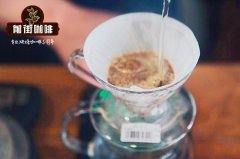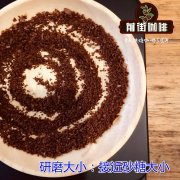Special treatment of Coffee by barrel fermentation in San Jose, Colombia. Introduction to the source of rum flavor

Professional coffee knowledge exchange more coffee bean information please follow the coffee workshop (Wechat official account cafe_style)
Fermentation and washing treatment of Colombian Coffee San Jose Rum barrel
Colombia San Jose Washed
-flavor-
Rum, cantaloupe, dark chocolate
Rum 、 Melon 、 Dark Chocolate
Country of origin: Colombia / Colombia
Producing area: Caldas province / Caldas
Manor: San Jose Manor / Finca San Jose
Bean seed: Castillo, Naranjal
Altitude: 1750m
Treatment: rum barrel fermentation, water washing treatment
This Colombian coffee raw bean is selected as the three-time preferred Supremo grade Castillo Castillo Naranjal tree species, which is peeled and fermented in an oak barrel at a low temperature. After fermentation, it is washed and dried on a sun rack.
This method of treatment originated from Finka. Monsalve Botero, the hostess of San Jose Manor, had the idea that one day she was accompanying her husband (working in rum oak barrel production and rum brewing) to fill the rum distillate for fermentation when she suddenly thought that if the coffee beans were fermented in oak barrels, would there be a different flavor? To this end, the hostess Monsalve Botero began in 2013 to try different length of Colombian oak barrels for different fermentation time of wine-making low-temperature fermentation, this bean is one of the best in various attempts.
Brief introduction:
In the trend of boutique coffee in recent years, ─ Finka San Jose (Finca San Jose Estate), a century-old estate in Colombia, has been actively trying to find a breakthrough to take a different path for itself. Monsalve Botero, the hostess of Fenka San Jose Manor, has a husband who specializes in making rum oak barrels and brewing rum. One day she wondered if there would be a more different flavor if the raw coffee beans were fermented in oak barrels. As a result, Monsalve Botero began experimenting with low-temperature fermentation in Colombian oak barrels in 2013 and finally found an ideal way this year to produce fermented beans that are different from those normally washed in oak barrels.
Above.
Personal experience:
At first, when I knew about this bean, there were only samples, dozens of grams of beans already baked in Colombia, I didn't know any manor, I didn't know when to bake, what degree of baking, only beans that had been treated in oak barrels. I don't even know whether the export certificate is available or not (I later learned that the sample at that time had been baked for about two months, and it was baked until the second burst). At that time, I only thought: the aroma of this wine is too strong! It's so distinctive! Although the performance in the latter part was a little empty.
But because the information is so unclear, we can only wait, and expect that the baking technology of the landowner is not good, and the flavor of the beans will be better. After a period of time, I knew the more detailed information about raw beans and the export certificate.
When the bean merchant told me more detailed information about Colombian coffee producing areas, it actually reminded me of teacher Han Huaizong's Facebook post, which mentioned "…"... His practice is that after peeling, the shell beans do not touch the water, and the bucket is sealed to prevent flies from attacking. Purely based on health considerations, fermentation degumming is carried out for two to three days at a low temperature of about 10 degrees Celsius in winter, and then washed. No material was mistakenly hit into low-temperature and low-oxygen fermentation. This is somewhat similar to the carbon dioxide impregnation method won by Australian barista Sasa Sectic in 2015, that is, carbon dioxide produced by sugar fermentation helps anaerobes gain an advantage, and the acid and aroma produced during fermentation are better than those produced by aerobic bacteria. Wang ce, who won the 2017 World Cup for Taiwan, also used the low-temperature and oxygen-free tanning technique of the Salvadoran master. Low-temperature anaerobic fermentation or fermentation to control oxygen content has become a new trend and outstanding study of coffee production in recent years. "
I think this Xing Xu is the same. San Jose Manor may not be the first manor to do so, but he has created another strong flavor.
The first time I got raw beans, the smell I smelled was' milk jujube', more or less wearing a little grape and Chinese wolfberry flavor, but a complete general direction is ripe milk jujube, super sweet kind. And it always smells like that when baking.
Because it is Colombian coffee beans, so in the first pot of roasting, I choose shallow roasting. Although the fruity and fermented aromas are obviously suitable for shallow roasting, I still want to make a little thick. However, after cooking, it was found that its flavor lost a little quickly in the middle and back of the baking. Although after the cultivation of beans, the taste is still quite smooth and delicious, but the vitality of the taste still can not come back. So it was decided immediately that the presentation after that would be mainly shallow baking.
In addition, the performance in cooking is also very special, the same freshly baked beans, the speed of passing water is very fast, and when the exhaust is very exuberant, it will swell to half and suddenly bleed out. For this phenomenon, my guess is: it may be very small oil content, resulting in very small surface tension, will not be able to grasp water, can not grasp the air.
As it happens, not long ago, Dr. Shao Changping Shao's Facebook post (post link) quoted foreign research data about the hydrolysis of lipids, forming acids and alcohols (original links). To explain why ice drop coffee has a wine-like fermented taste after aging.
Therefore, I suspect that at the beginning of the oak barrel fermented beans in San Jose, the lipids in the beans have been hydrolyzed into acids and alcohols, which is why there is such a full and rich wine.
Attached below are two photos of the thick boiling method that I developed for the Melitta flat-bottomed filter cup. The originally inflated powder layer has become a sinkhole-like collapse, which should also be regarded as evidence of the aforementioned opinion.
END
Important Notice :
前街咖啡 FrontStreet Coffee has moved to new addredd:
FrontStreet Coffee Address: 315,Donghua East Road,GuangZhou
Tel:020 38364473
- Prev

Colombia Huilan Magdalena SUP washed coffee beans flavor introduction_Huilan coffee taste characteristics
Professional coffee knowledge exchange More coffee bean information Please pay attention to coffee workshop (Weixin Official Accounts cafe_style) Colombia RFA Huila Magdalena Supremo Colombia coffee Huila Magdalena SUP Rainforest Alliance Origin: SanAgustin,Huila Elevation: -m Harvest period: April-May and October-December (main batch) Variety: Castillo, Colombia
- Next

Introduction of beans from the list of Origin of Prada, Tolima, Colombia-Colombian Black Coffee recommendation
For more information on coffee beans, please follow Coffee Workshop (Wechat official account cafe_style). A thriving family organization of coffee farmers has formed the association de Productores Egolgicos Planadas (ASOPEP), one of the few certified Fairtrade and organic coffee producers in Colombia. No wonder people are in and around Planadas
Related
- Detailed explanation of Jadeite planting Land in Panamanian Jadeite Manor introduction to the grading system of Jadeite competitive bidding, Red bid, Green bid and Rose Summer
- Story of Coffee planting in Brenka region of Costa Rica Stonehenge Manor anaerobic heavy honey treatment of flavor mouth
- What's on the barrel of Blue Mountain Coffee beans?
- Can American coffee also pull flowers? How to use hot American style to pull out a good-looking pattern?
- Can you make a cold extract with coffee beans? What is the right proportion for cold-extracted coffee formula?
- Indonesian PWN Gold Mandrine Coffee Origin Features Flavor How to Chong? Mandolin coffee is American.
- A brief introduction to the flavor characteristics of Brazilian yellow bourbon coffee beans
- What is the effect of different water quality on the flavor of cold-extracted coffee? What kind of water is best for brewing coffee?
- Why do you think of Rose Summer whenever you mention Panamanian coffee?
- Introduction to the characteristics of authentic blue mountain coffee bean producing areas? What is the CIB Coffee Authority in Jamaica?

